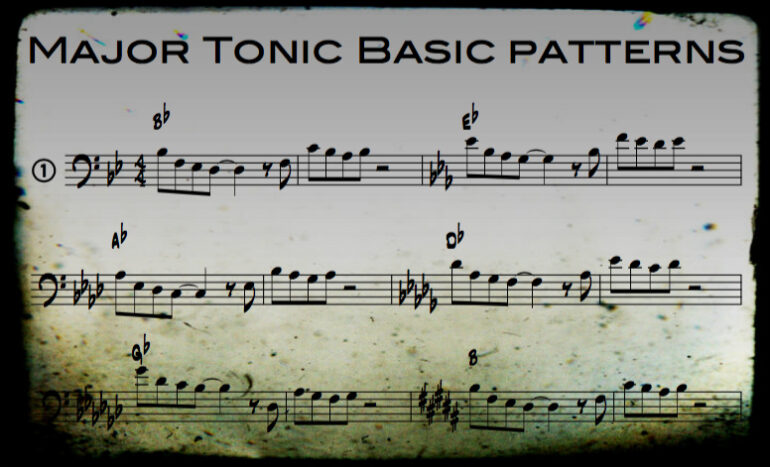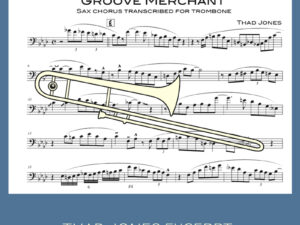
Basic patterns with free sheet music and audio
This is a free trombone lesson about improvising over basic tonic chords in all keys. It features sheet music and audio files.
When I decided to turn DigitalTrombone into a membership site, this jazz pattern was among the first to be created. In the member’s section, you will find another 400 pages of jazz patterns with clear instructions written especially for trombone.
Disclaimer
This trombone lesson has some downsides. Here is a shortlist of what it won’t help you with.
- Will not increase your ability to attract the opposite sex.
- Will not make you look cool. Just sound cool.
- Will not keep gigs away from your calendar.
- Will not alienate banjo players.
If you can accept these conditions, please read on and become a better trombone player.
Here is a video where I try to demonstrate some basic from-the-heart patterns jamming with the audio file found below.
Playing jazz phrases that don’t come from your heart ?
I have heard too many jazz students (and pros) play advanced upper structure phrases, turning complicated scales inside out and moving complex patterns around. Being able to do so is great, but there is one big BUT involved.
Often these players are so eager to sound like their jazz heroes that they forget to get the basics in place. And you don’t fool me – or your audience! I find it disturbing listening to a player who, for a few bars is playing hip, advanced phrases exploring the outer edges of the harmonies, only to follow up with an attempt to play a simple phrase but with a major seventh on a dominant chord. Or neglecting to go to the subdominant in the fifth bar of a straight-ahead blues after showcasing outer space alternative pentatonic scale patterns.
It is like cooking a Michelin-worthy dish of marinated shark fillets with deep ocean seaweed salad but forgetting to add salt. Or serving an endangered wildlife casserole without tasting it first (ok, that might not be the only problem with that casserole).
Would you ever serve food without tasting it first? In my world that equals playing jazz phrases that you know theoretically should work over a certain chord but you have no idea of how it sounds before it comes out of your trombone bell, instead of playing something you can actually feel and hear inside your head. If this means you have to get rid of some of your fancy upper structure theoretical hipness then that is fine with me.
Don’t get me wrong, you should attempt to play stuff you are a bit uncertain of and don’t know exactly how it will sound. This will move you forward. But Don’t do that all the time, and be sure to open your ears wide first.
Get access to the largest collection of trombone material on the web now.
Outside vs. inside jazz phrases
In my perspective, playing advanced melodic lines when improvising, is only interesting if you are able to use it as a contrast to something more simple or familiar. This is why I am not too fond of free avant-garde jazz – I miss the contrast between the familiar and the experimental stuff, I don’t just want one side of the story. This is my personal view and you are entitled to disagree.
A nice contrast to your outer space lines would be an inside phrase over a basic chord. Most jazz tunes give you the opportunity to play simple, melodic stuff as well as advanced patterns, and I suggest you make use of that.
Try this basic jazz pattern exercise and become a better human
This is a pattern originally intended for a book with the working title “Patterns For Two-armed But Creative Trombone Players That Want To Become Greater Jazz Players Than They Currently Are” but turned into something much bigger. The pattern lets you to play simple phrases in all keys, with an audio track to back you up. My guess is that you will find out that some keys just won’t pop out of your horn as they should. Gb major, I’m talking to you, why can’t you be more like my buddy F major?!?
First, just play the pattern reading the sheet music. Try different tempos. Then try to memorize the pattern and play it in all twelve keys again. When this is getting comfortable, try to play small variations of the phrase on the fly. Can you transpose the phrase with the variation you just made? Or does it make more sense to tweak the phrase in another way in the next key because of trombone physics? Now you are doing some real work, work that makes you both a better musician and trombone player.
Getting the basics in place
With these sorts of jazz exercises, you will lay a good foundation for your improvising. Starting with simple phrases enables you to hear and understand what you are playing. At the same time, you get a healthy technical trombone workout and become much better at finding your way around the horn in different keys. Slowly, you will be able to hear and feel more complex phrases – and there is plenty of that kind in the Jazz patterns chapter in the member’s section. Did I mention the 14 days free trial?
Any downsides with this method?
Plenty! Here is a shortlist of what it won’t help you with.
- Will not increase your ability to attract the opposite sex.
- Will not make you look cool. Just sound cool.
- Will not keep gigs away from your calendar.
- Will not alienate banjo players.
With these warnings in place, I suggest you have a go with the free sheet music and audio tracks provided below.
[ngg_images source=”galleries” container_ids=”63″ display_type=”photocrati-nextgen_basic_thumbnails” override_thumbnail_settings=”0″ thumbnail_width=”100″ thumbnail_height=”75″ thumbnail_crop=”1″ images_per_page=”20″ number_of_columns=”0″ ajax_pagination=”0″ show_all_in_lightbox=”0″ use_imagebrowser_effect=”0″ show_slideshow_link=”0″ slideshow_link_text=”[Show as slideshow]” order_by=”sortorder” order_direction=”ASC” returns=”included” maximum_entity_count=”500″]
Beware of the not-so-groovy robotic rhythm section, this is not real music… But it is a useful tool for practicing.
Let me know if you find this is helpful. Play great, and make sure to hear what you play and only play what you hear, if you hear what I say.
Anders Larson
Get access to the largest collection of trombone material on the web now.
9 Comments
-
I love that you have transposed the patterns to all keys. I have many educational trombone books that show you a pattern in one key then add the phrase “Now transpose and practice this in every keys” I have limited time to practice I want to spend my time with lips on the mouthpiece not transcribing exercices. Thank you.
Reserve me a copy. -
Thanks for an inspiring donation to the trombone community.
John Lawson
Fitzgerald, Georgia USA -
Anders- these are very good. Important not to duplicate Rich Willey’s “Jazz improv materials handbook” but I’m sure you have seen this. Cheers.
-
Thank you! Keep it coming
-
Keep it coming!
Thank you -
Thanks for providing these great exercises to help practice flow and flexibility.
-
Excellent, thanks!
-
This is an excellent site EXCEPT that I am unable to print anything . I don’t play from the computer; I play from my music stand. Thus, I am unable to fully take advantage of your site. Margaret
-
Author
Hi Margaret, In the member’s section it is now possible to print the sheet music. If you don’t have an account, you can sign up for a free trial and see if it does the trick for you (I bet it does!) Kind regards, Anders Larson, founder




